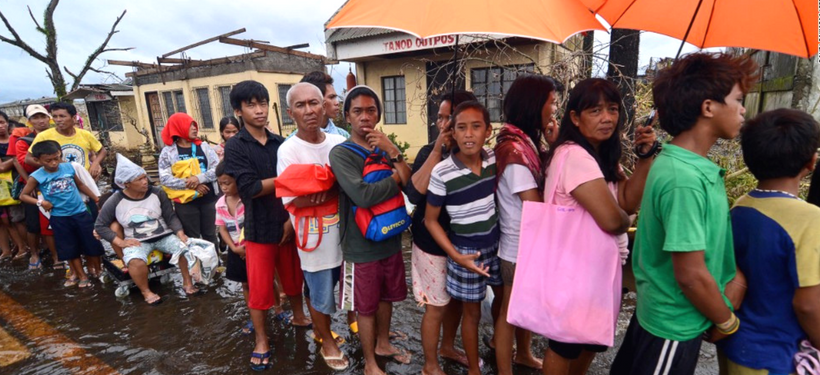
FPTI and Banilad Study Center (BSC) wanted to do a trip for victims of super typhoon Yolanda. They have already helped in an outreach in Bohol, but the calamity of Yolanda was far greater than the earthquake. Since logistics seemed immense, with safety issues still to be cleared, we had to wait for some orientation. When we learned that BCPD went to Javier and had a big group going, we decided to go to the north of Cebu.
Since I participated in Cebu Neuroscience Society’s medical mission in Barangay Talisay, Daanbantayan, and Northern Cebu last November 22, I didn’t hesitate to volunteer in the relief efforts to Bantayan. I initially wanted to ensure safety and check the needs of the place, but I realized that time is the real issue. The longer we wait, the less chance of seeing the devastation, and the less chance of helping people when they need us most. The lines to the RORO boats were very long on weekends, since many private citizens use it to deliver relief goods to Bantayan Island in big trucks and cars. Considering the transportation circumstances, we deem it best to go on a weekday. December 3 seemed to be a good day, it was a Tuesday.
Since November 8, two people from the office of Cynthia – friend of Jovy – had gone to Leyte to be with their family. Cynthia started a fundraising campaign to help her employees and the center. She had a massive email campaign asking family members, friends, clients, contacts, etc. to donate thru Paypal in Banilad Study Center’s Google site.
Relief goods were gathered since the earthquake; hence, repacking and distribution had become commonplace in BSC. We reached out to Kota beach employees and the teachers of the school beside it. Though we didn’t have enough resources to provide light housing materials, we continued giving relief goods, mostly food.
A day before December 2, Beth and some students packed goods for about 100 people. Sherry Arabaca of Cagayan de Oro City gave 4 boxes of relief goods which we transported via plane. We’re still waiting for more boxes which she shipped via boat.
We left BSC before 6:00 a.m. Amazingly, we had no problem reaching the Port of Jagnaya before 9:00 a.m. Having been instructed by Mr. Lopez, the port personnel also facilitated our departure. Taking a short break from my patients, those who joined me in the relief operations were Dr. Jaja (pediatrician who has gone to various outreach activities), Tesa (florist and interior designer), April (my nurse colleague), and 2 BCPD students. These two students are natives of Bantayan Island. Our trip was well-documented. Thanks to Sandy, our “film director” on board. With his small camera, he took photos and videos of our relief efforts. He’s a freelancer from Austria who had also covered BCPD’s family day.
Upon arrival at Sta. Fe port, we saw a banner “Bantayan Island will rise again”. This made us smile, but it was also coupled by the upbeat mood of the place that reflected “kaya natin ito!” which means “we can do this!” We were also at the port met by Roa’s mother who came in from an island off Bantayan.
I wanted to show Mr. Mulliar more sights of the devastation, so I inquired with our contact in Kota beach, Mr. Chris. The latter replied that Lawis, Madridejos is the worst hit by the typhoon. It is another town north of Sta. Fe, about 26km away. We started planning to go to Lawis. Our driver is the husband of Luisa, BSC receptionist. He got in touch with Mr. Jose T. Rio, municipal accountant of Lawis, Madridejos. Small world, Mr. Rio is also the uncle of Luisa. Mr. Rio instructed us just to look for him once we arrive the place.
We went to one of the historical schools built by Americans in the island. Prior to Yolanda, the structure already needed restoration. But after the typhoon, it now tilts menacingly to the left and poses danger to passers-by. The wall had a sign painted “Peligro, ayaw pagduol” which means “Danger, do not go near.”
We were met by Arch. Chris Hubahib, nephew of May. He showed us the way to Kota beach which is only 10 minutes away. In Kota beach, we were welcomed by a sight of roofless guest huts and restaurants. Mr. Gonzales is the owner of the beach. His house was destroyed and he resides in one hut built on scraps of roofing materials. As we conversed with Mr. Gonzales, we realized that the typhoon was a very catastrophic one. He recounted that the wind became a tornado, returned thrice, and destroyed everything. When the people started moving inland due to the water rise, it dawned on him the ominous reality of death: children who couldn’t swim would walk-jump along with their parents to prevent from drowning.
Mr. Mulliar directed us to unload the relief goods and to start distributing them. Each employee received a colored bag, a “Christmas bundle of joy” of relief goods, and a ‘trapal’ (plastic material that can serve as temporary roofing). Roa’s mom was happy to receive our relief goods. When we began to talk to her, Mr. Mulliar also started filming our interview. Mrs. Roa started crying when she recalled that “the only thing *standing* of my house is the floor” and we could barely contain our own tears.
We proceeded to Sta. Fe High School, which is just adjacent to Kota beach. We told the Principal, Mr. Marianico E. Ilustrisimo, our plan to give him goods for his teachers. He was very happy to accommodate us. Right away he said, “I will also give this to the students.” With his big heart, he knew that everyone in the school were affected. Sandy filmed the students who were under temporary trapal tents or under the eaves of roofless classrooms listening to their teachers. It was super hot. During our interview, Mr. Ilustrisimo recounted that during the storm he was in the command post with other fellow Bantayan men; the school guard ran to him and reported that all roofs were blown away. Mr. Ilustrisimo berated him for having risked his life to come to the post. He also showed us papers and books laid down under the sun for drying, the computers were all wet and non-functioning, sand on his roofless office and on his window sill brought in by the storm. He was actually preparing for an afternoon visit by an assistant secretary from Department of Education (DepEd). He looked sadly at the papers and folders he had been preparing and now they are all a mess. We asked the help of boys to bring in the goods from the van into his office.
When the principal brought us to the elementary school, one teacher told us how she moved into a “new” home. Since Yolanda swept away the roof of their bedroom, the entire family sleeps in the sala. The roof of their sala and kitchen was the only one spared. She said, “I live now in a ‘studio-type’ condominium!” Mr. Marianico showed an optimism characteristic of the place. He even invited us to come back in January for the life-saving competition that he is co-organizing.
We left for the 3:30 p.m. RORO trip back to Cebu. On our way to the port, I told Sandy about the teacher’s anecdote on her studio-type condo. In contrast to people from other countries who get sad or angry about little things (e.g. a dent in a car) and complain a lot, he marveled at Filipinos’ positive outlook. He had been to Thailand after the tsunami and noticed that people were also peaceful and calm. As a photojournalist, he had gone to many Asian countries and observed how Asians respond to calamities. But the optimism of Filipinos is extraordinary, to the point that they have the “audacity” to even joke about things. Sandy concluded that it must be rooted from our Christian spirit. We arrived in Jagnaya around 4:30 p.m. and passed by the beach strip in San Remegio to catch a picture of the sunset.
Our driver, Mr. Danny dropped Sandy to Bogo; he will stay there for the night en route to Leyte. We arrived in Cebu City around 8:00 p.m. After sending home the students, Mr. Danny arrived around 9:30 p.m.
After our successful outreach, we learned that rehabilitation is ongoing and food supply is already near normal. Moving forward, we hope to get funding for a weeklong construction work this coming 2014.
Overall, our mission of distributing relief goods has been accomplished. On the side, we were also able to do a preparatory visit to see what else we can be done for the community in the future.
Dr. Jaja asked me privately, “I was so happy after the trip, isn’t this selfish of me?” I answered her, “No, of course we should be happy!”
